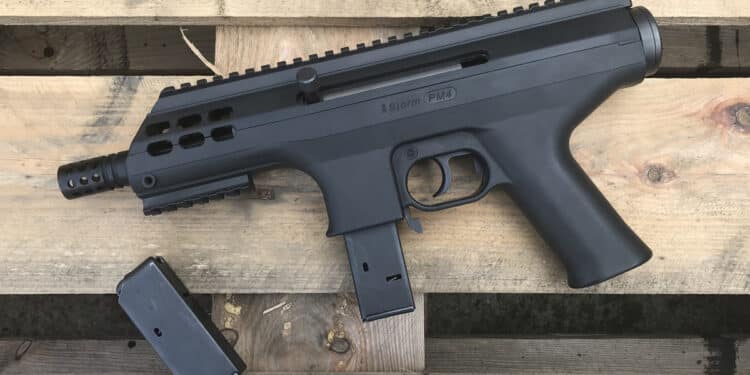by Pierangelo Tendas – all photos by BCM Europearms
From the mid-2000s to the mid-2010s, an Italian company experimented on a large-size tactical pistol for home and property defense and for private security that never entered mass production: let’s take a look at it and see if there’s a future ahead for the design!
Albeit not successful as its creators (Roberto Teppa and Claudio Gritti from the Turin-based SITES S.p.A. company) would have wanted it to be, the SITES M4 Spectre sub-machine gun was by all accounts one of the most technically innovative and interesting firearms of the 1980s.
The Spectre design also saw civilian sales on both sides of the Atlantic: a stockless, single-grip variant dubbed the “Spectre HC” would be marketed on the U.S. civilian market, while European shooters had the choice of the “Falcon” pistol (essentially a semi-automatic M4 Spectre with a removable vertical foregrip and upfolding stock) and the “Ranger” carbine, same as above but with a longer barrel.
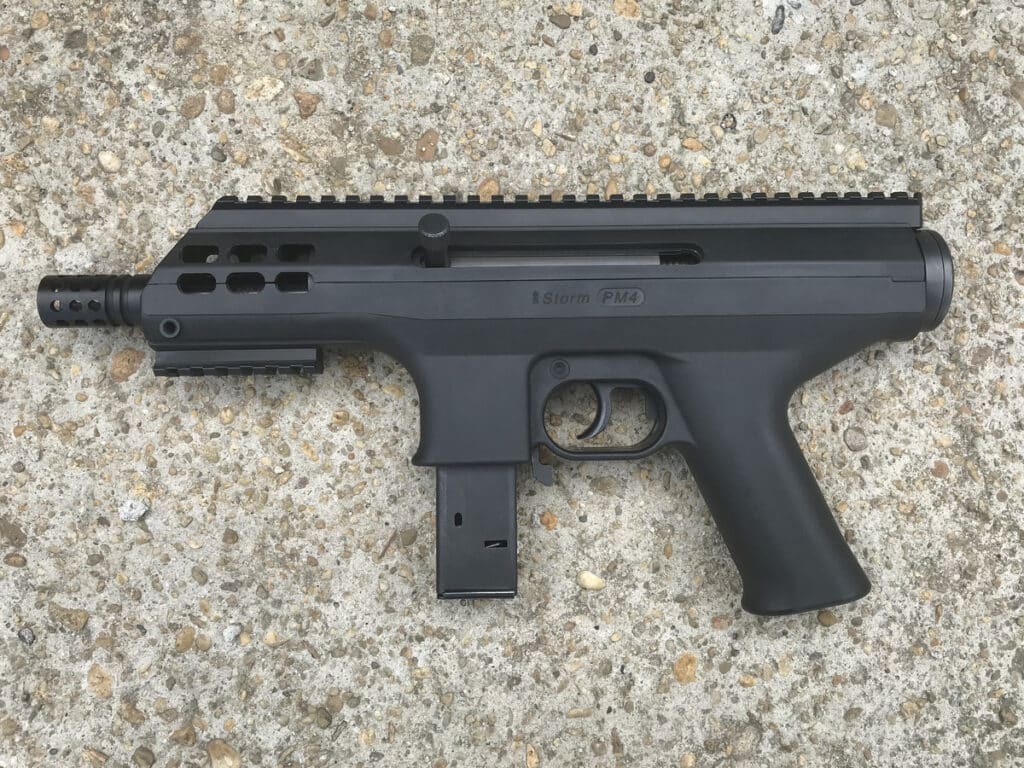
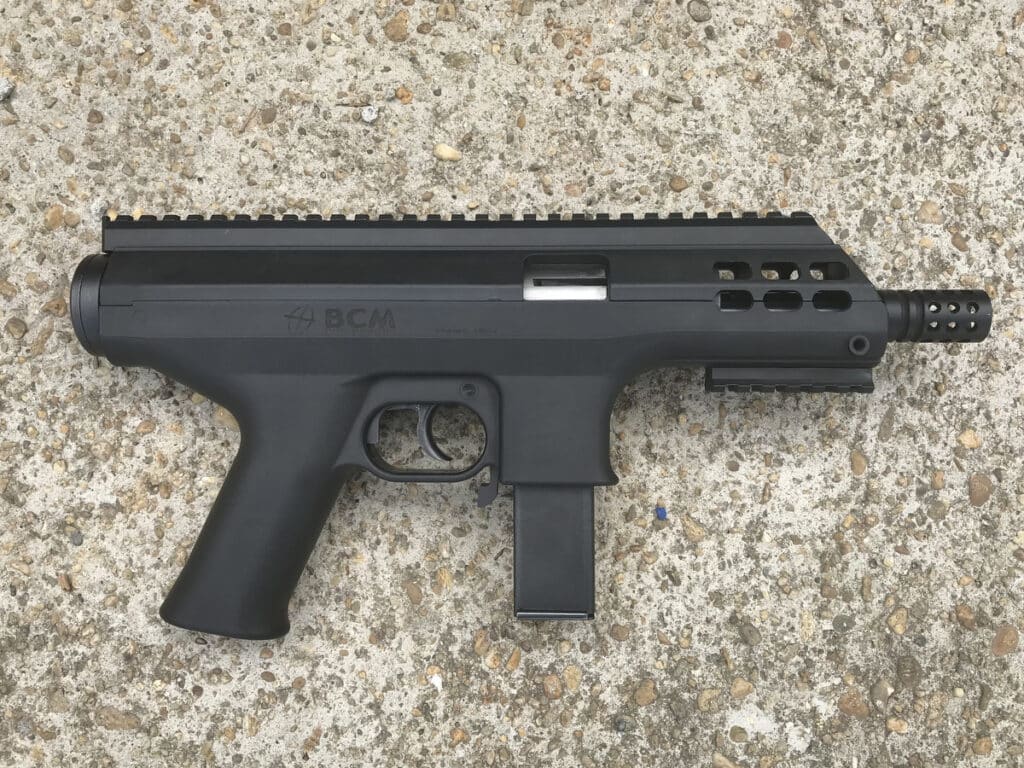
SITES shut down in 1997, but Gritti – now operating a company called Greco Sport S.A. in Switzerland – would continue to assemble and sell Spectre sub-machine guns, pistols and carbines until 2001.
For years, however, its creators would attempt to revise and improve the concept into an aesthetically new, more compact and ergonomically-friendly package that would be marketed chiefly as a semi-automatic pistol in two barrel lengths (5.3-inch (13.5cm) and or 8.6-inch (22 cm)), with a fast clip-on butt-stock available as an optional as Europe lacks the short barrel rifle restrictions of the U.S., that could become a desirable alternative for individuals looking for a high-capacity, highly controllable home and property defense pistol, as well as for local law enforcement and private security personnel, particularly those working cash-in-transit duties.
The first prototype of what was meant to be the Spectre’s heir apparent would be showcased at the 2000 EXA gun expo in Brescia, Italy by Claudio Gritti’s new company, THOR Projects, headquartered in the Swiss city of Mendrisio. In 2003, once again at the EXA expo, the design was on display again, this time known as the PPM-1 “Storm”, and announcements were made that it would be manufactured in Italy by a company called Modulo Masterpiece S.a.s. – back then a newcomer whose product line included both a vast line of bolt-action long-range precision shooting rifles and a series of high-grade competition-oriented 1911 pistols, a throwback to the post-SITES days of Gritti, who had worked on 1911 handguns with the Bologna-based TECNEMA company from 1990 to 1996.
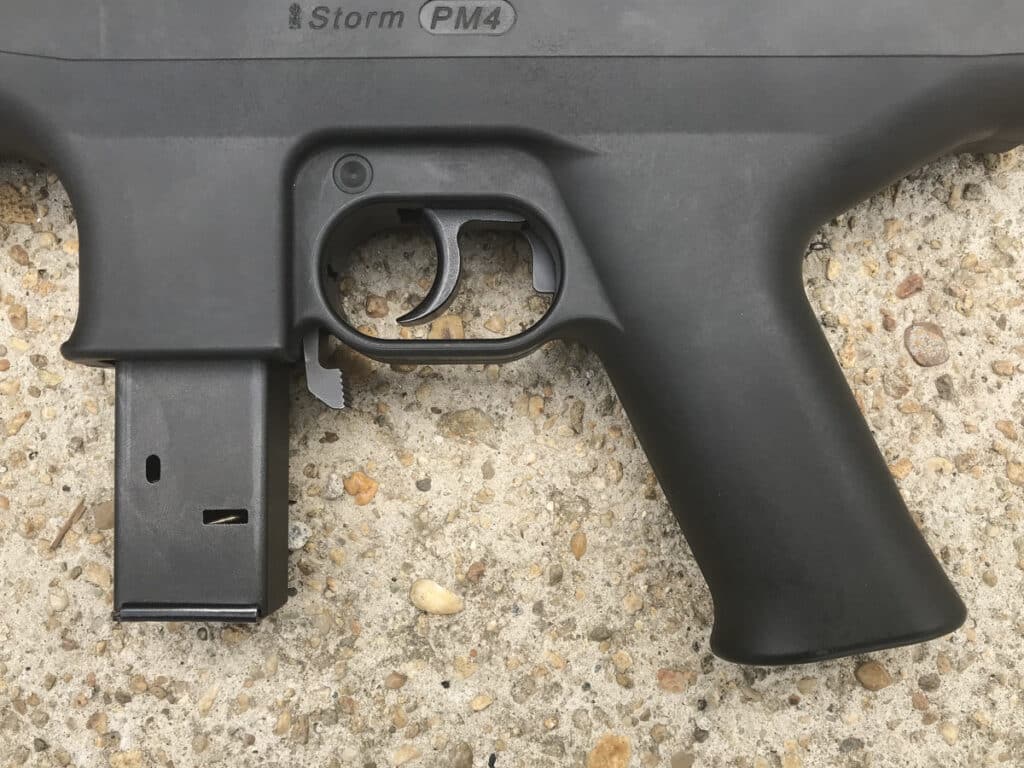
Differences between the Modulo Masterpiece and THOR Projects teams sadly led to the project being dropped not much later, with not a single PPM-1 being produced commercially. The Italian company, however, retained the rights for the design and, in 2008, it underwent a corporate restructuring, becoming known as BCM Europearms. The development of the Storm pistol – now called the PM4 Storm – continued all through the early 2010s, with the final version being revealed in 2015.
Technically speaking, the BCM Europearms PM4 Storm is a semi-automatic, locked breech pistol designed to be manufactured in three calibers – 9mm Luger, 40 Smith & Wesson, and 9×21 IMI – but ultimately produced in an extremely limited number (approximately fifteen) only in the latter.
As the heir apparent of the SITES Spectre sub-machine gun, the PM4 Storm was conceived to be ready for use at a moment’s notice, while still remaining perfectly safe to carry or transport given the relatively compact size – a true plus for bodyguards and other private security professionals working close protection details – and boasting an aggressive look and feel that would alone act as a deterrent against the less well-prepared and determined attackers. Gun grabbers in the United States would call this an “assault pistol”, but well, the makers of the Storm don’t shy away from it.
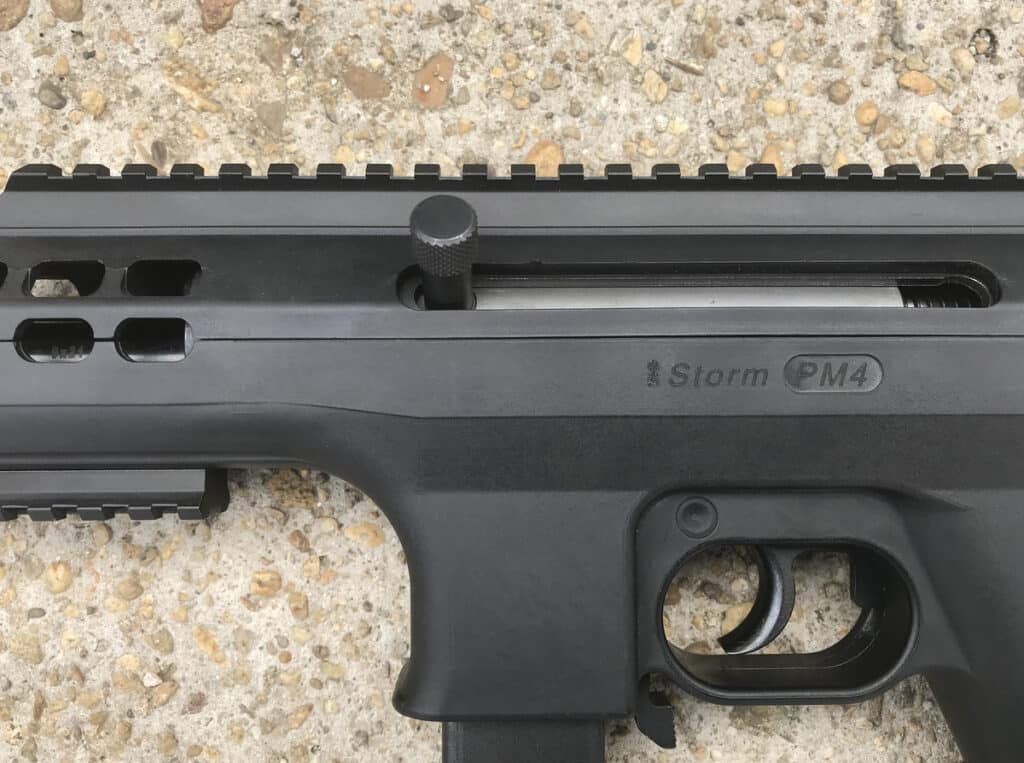
As many of you may remember, the SITES Spectre featured a SA/DA striker-fired (or better, linear-hammer fired) trigger group, quite unusual for a sub-machine gun: an ambidextrous decocking lever located over the grip, at thumb reach, replaced the standard manual safety and allowed the user to drop the striker safely on a loaded chamber with the selector set on semi-automatic or full-automatic fire.
The Spectre could thus be carried ready to fire, much like a revolver or a double-action pistol. All the operator would need to do, if the need arose, was to bring the gun to bear and pull the trigger; the first shot would be fired in double-action, the following rounds would be fired in single-action. The SA/DA trigger design also allowed shooters to restrike a chambered round in the event of a malfunction.
The PM4 “Storm” improves and elaborates on the original SA/DA trigger group of the Spectre, albeit ever so slightly, by replacing the old linear hammer with a standard hammer for easier manufacturing and offering a better trigger pull in double action.
At the heart of the PM4 Storm is a massive cylindrical bolt, with a large hook-type extractor. The bolt is hollow and houses a free-floating striker and the return spring; the entire bolt assembly runs within a (likewise cylindrical) steel receiver to which the trigger group is hinged at the bottom, housed in its own metal chassis with two side bars for easy inspection and maintenance.
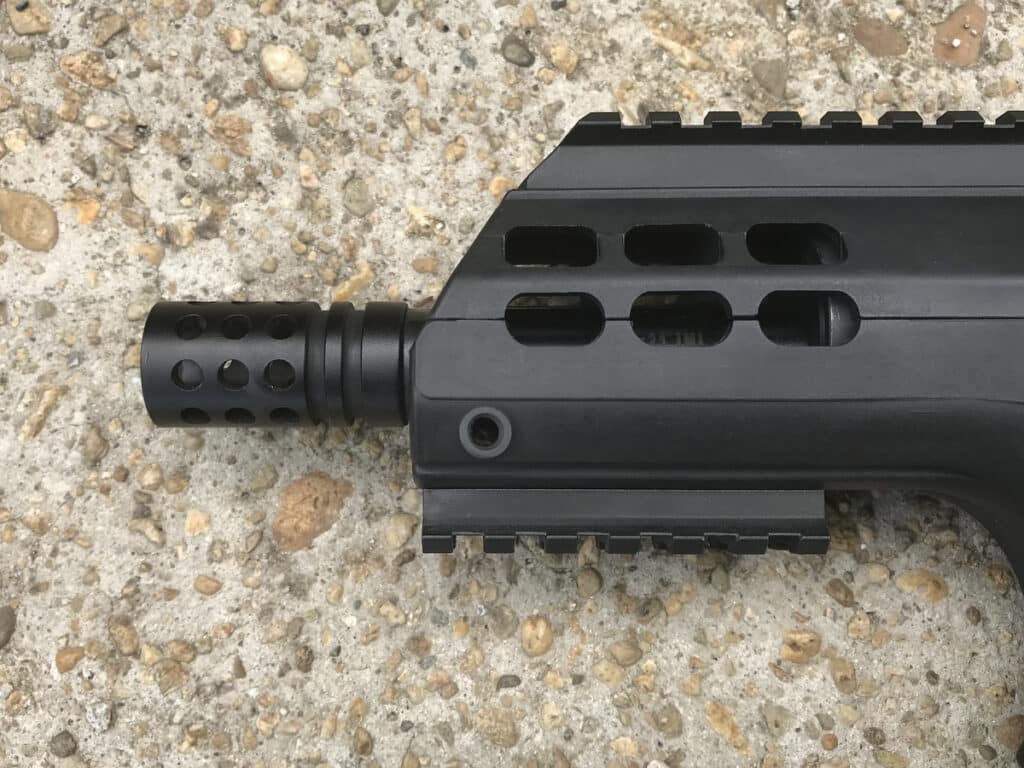
The charging handle of the PM4 Storm is screwed on to its seat within the bolt, is reciprocating, and runs into a slot cut on the left side of the receiver. It is also the only non-ambidextrous control of the gun, which in and by itself has very little controls, most notably no manual safety: a push-button located within the trigger guard, behind the trigger itself, acts as a decocker and engages the double-action.
The flat magazine catch is located right behind the mag well: it is meant to be operated by thumb, either by left- or right-handed shooters. The magazines don’t drop free and must be pulled away, although the PM4 Storm does lock open on an empty magazine.
Ditching the heavy, cumbersome and complex 50-rounds quad-stack “coffin” magazines of the original SITES Spectre, the Storm pistol has been conceived ever since its first iteration in the year 2000 to use tried and true, double-stack Uzi magazines. 15- and 20-round magazines were planned to be made available, but the pistol will feed through any iteration of the popular 9mm Uzi mag.
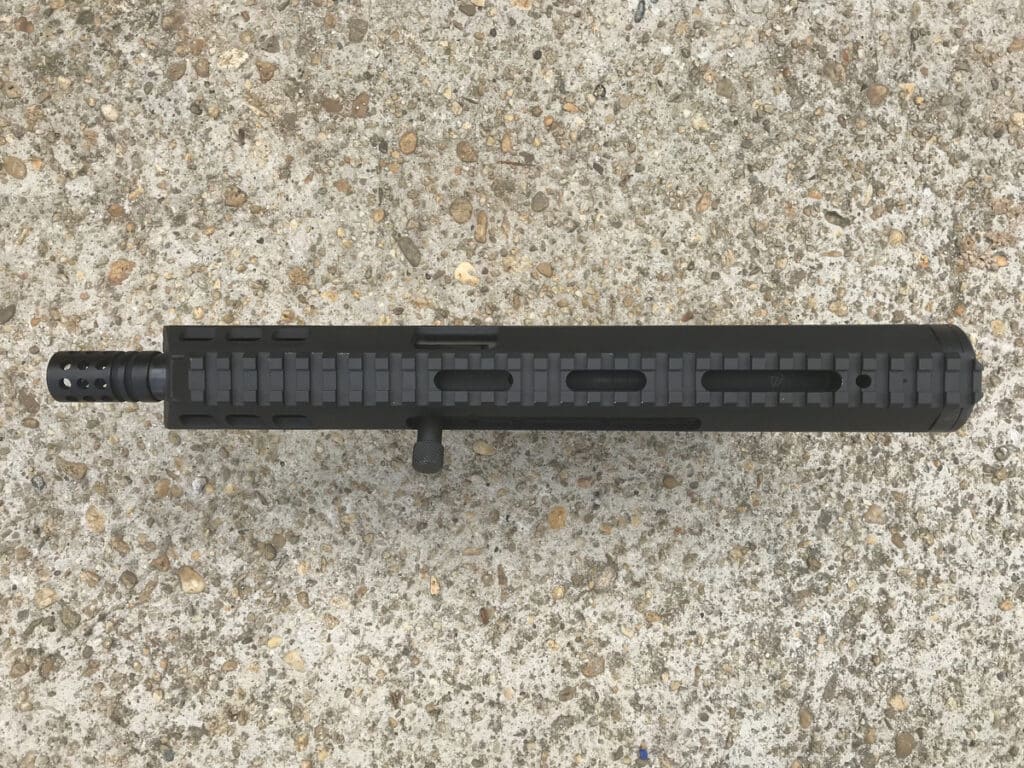
The mentioned steel receiver of the PM4 Storm is contained within a black high-strength polymer chassis; unscrewing the charging handle from its seat in the bolt and removing the rear endcap of the polymer chassis is required to field-strip the gun.
The chassis is composed of two parts: a lower, which includes the grip assembly and the magazine well; and the upper, featuring a full-length top MIL-STD 1913 Picatinny rail for optics or emergency flip-up iron sights.
Originally the PM4 Storm had to feature a shorter top rail and a set of integral sights, consisting of a fixed front post and an adjustable rear sight assembly; the idea was ditched in the final iteration in favor of a full-length top rail, as were many features of the previous prototypes such as a detachable pistol grip and a different, overall more smooth and sci-fi-ish design of the polymer chassis.
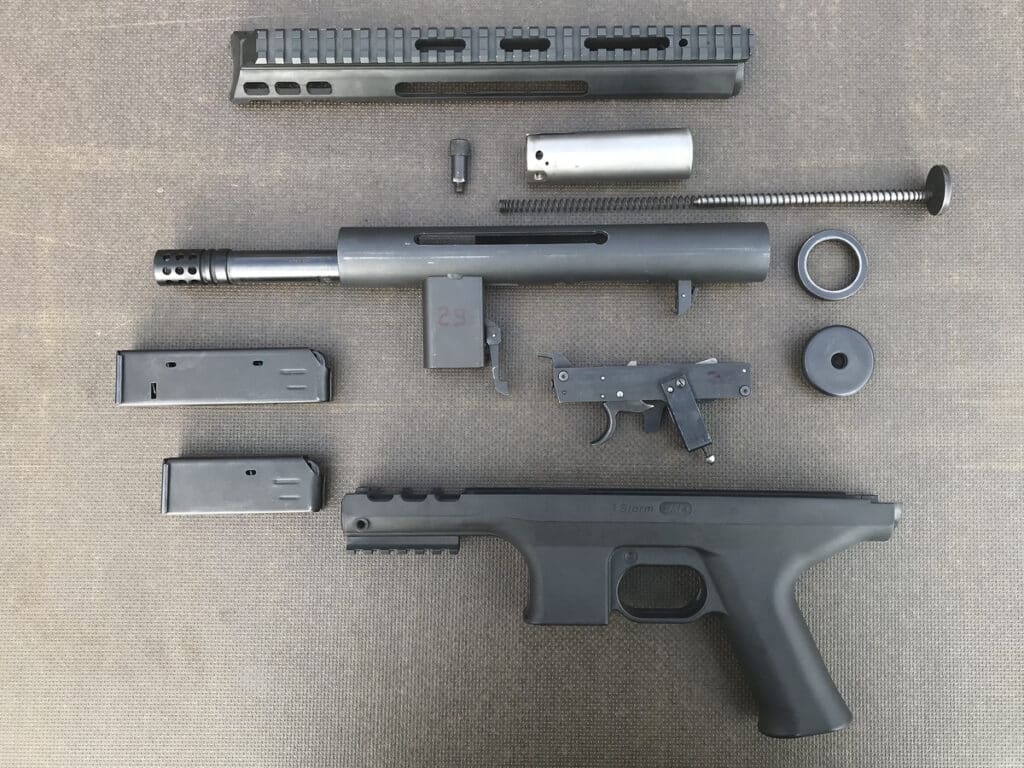
A second, removable screw-on piece of Picatinny rail is located in front of the magazine well, providing an interface point for tactical accessories or for a foregrip – once again, there’s no such thing as SBR or AOW regulations in Italy.
The barrel of the PM4 Storm pistol is 14.5 centimeters long (5.7 inches for those using freedom units), and ends in a thread-on, multi-port proprietary muzzle device that doubles as a flash hider and compensator. Like the SITES Spectre, the PM4 Storm opts for a sinusoidal rifling pattern, with six right-handed grooves and a very long twist rate (1 turn in approximately 1 meter, which would be 1:39.3-inch). The sinusoidal pattern is extremely effective in tightening groups, not as much as you’d need to come out on top in a shooting competition, but definitely enough to bring the hostiles down when the prize on the line is your own life.
As mentioned above, time and time again, there’s no such thing as SBR restrictions in Italy and in most of Europe. While in the US the difference between a long gun and a handgun is the intended mode of use – with long guns being “originally conceived to be fired from the shoulder” – the European Firearms Directive, ever since its first iteration in 1991, designates a long gun as a firearm that is both longer than 60 cm (23.6 inches) and has a barrel longer than 30 cm (11.8 inches), with anything shorter being classified as a handgun, regardless of any buttstocks or foregrips.
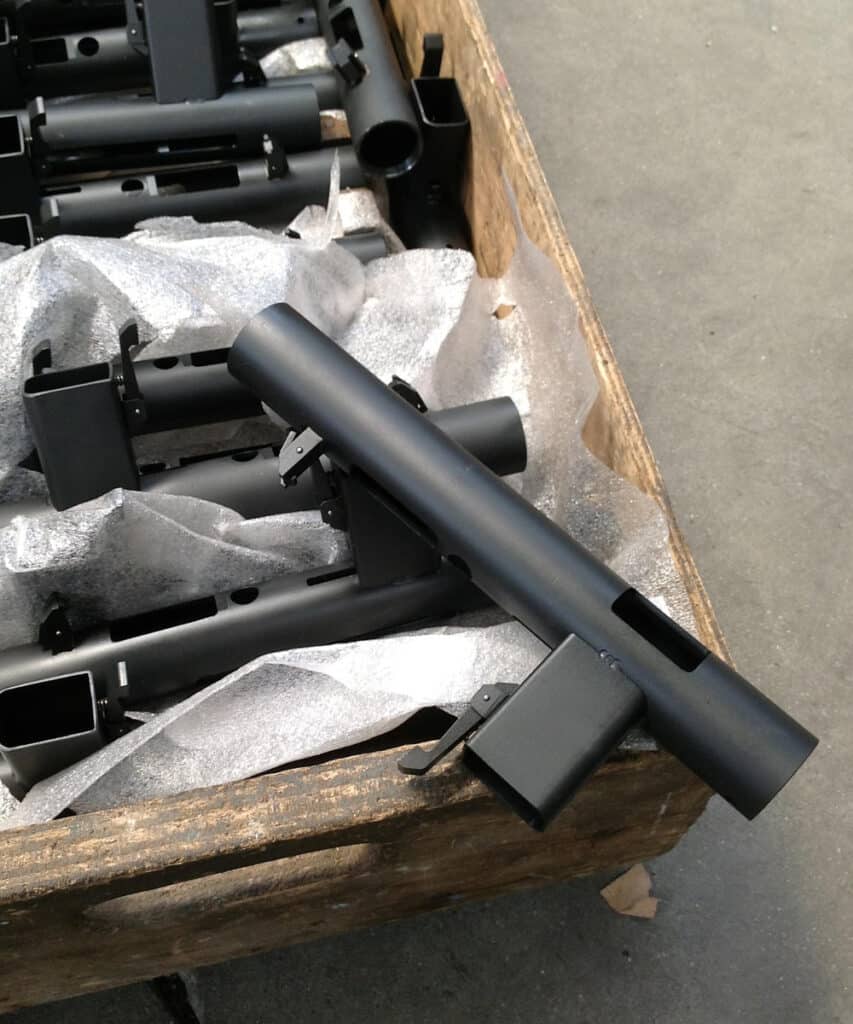
The Italian law, which like many other gun laws in European countries implemented the directive, goes so far as to state that the overall length of a firearm equipped with a collapsible or folding buttstock must be measured with the stock in its fully collapsed or closed position, thus focusing on concealability rather than the possibility of firing the gun from the shoulder.
It is, thus, no wonder that the Storm pistol was always planned to be equipped with a buttstock. As previously mentioned, the original prototype from THOR Projects in Switzerland came with a clip-on fixed stock, and as the various iterations of the design came to be, the companies involved in the development experimented with fixed, folding, removable, and collapsing wire metal stocks.
In the current iteration, the PM4 Storm’s factory chassis end cap can optionally be replaced with another that is threaded at the end for a MIL-SPEC or commercial buffer tube, allowing the use of M4-type collapsible buttstocks. The mount is hinged to fold to one side, making the PM4 Storm compact enough for concealed carry under a jacket even when the stock is installed.
Now, the PM4 Storm is by no means a diminutive firearm, standing in at 39.5 centimeters (15.5 inches) in overall length without a stock, or with the stock folded, while topping the scale at 2.5 kilograms approximately (5.51 pounds) when empty. But considering it is meant for rapid fire in close quarters, the extra mass helps keeping recoil and muzzle climb under control.
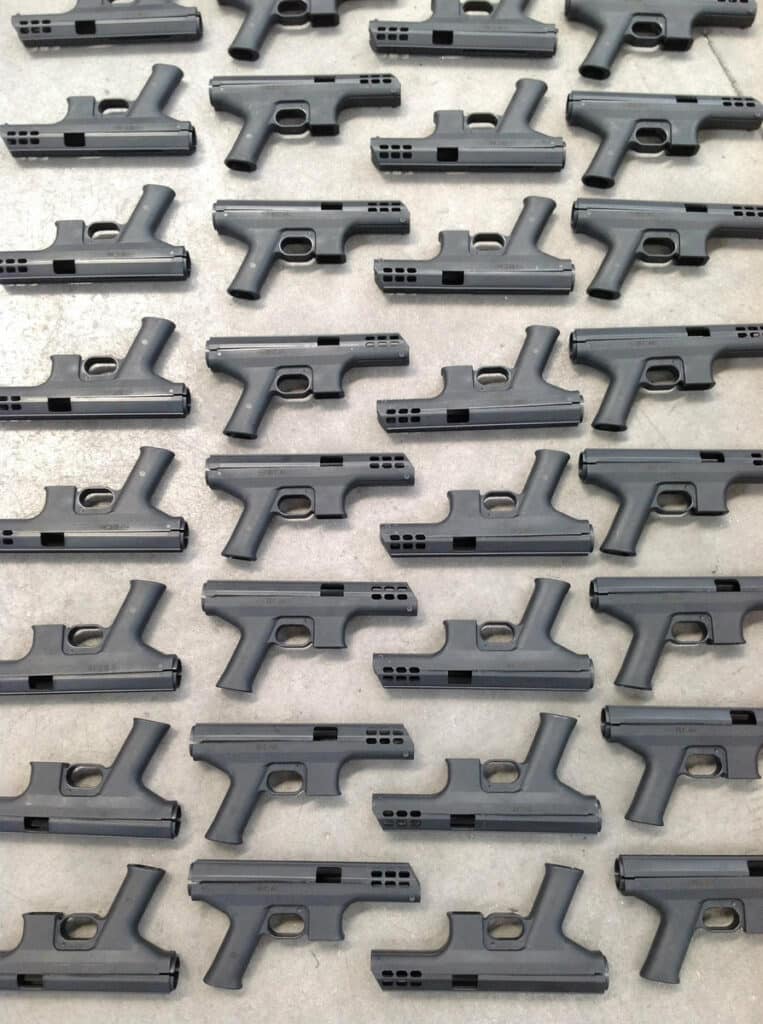
THOR Projects and Modulo Masterpiece briefly experimented with a carbine version, to be called the CM4, that would tentatively be 77cm (30.31 inches) long overall and feature a long barrel and a fixed buttstock.
The carbine project has however since being shelved; the reason for its demise are unknown, but once again, with SBR restrictions not really being a thing in Italy and most of Europe, the manufacturing company wouldn’t have to worry about overall length. The reader must also remember that the Storm pistol was conceived initially in the early 2000s, over a decade before the PCC craze ever saw the light of the day.
And to be more accurate, “shelved” is a description that applies to the entirety of the PM4 Storm pistol project. After a limited run of merely fifteen commercial samples, BCM Europearms put the production of the Storm pistol on an indefinite hiatus to focus on their core business of top-tier bolt-action competition rifles for the European commercial markets and high-precision sniping platforms for the Italian military and other professional customers worldwide.
“Indefinite hiatus”, however, doesn’t mean – in the words of the owner and CEO of BCM Europearms, Gianmattia Molina – that the PM4 Storm is dead. It’s on the back burner, for sure, but still in his mind; and the company still has the technology and owns the rights to the design.
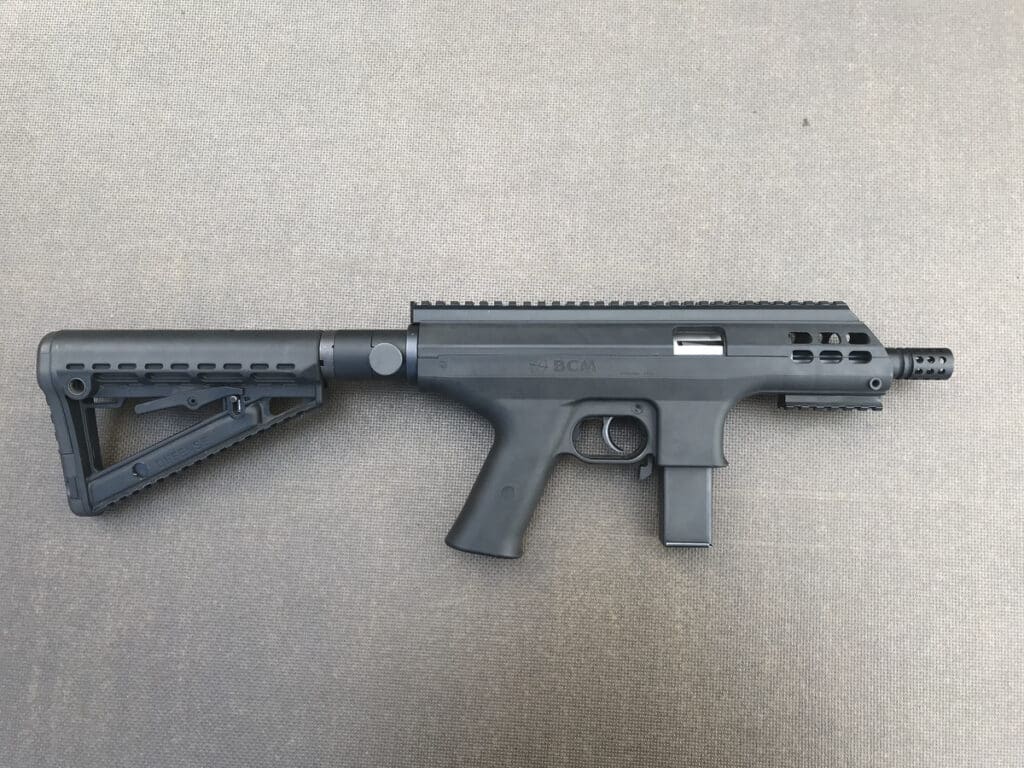
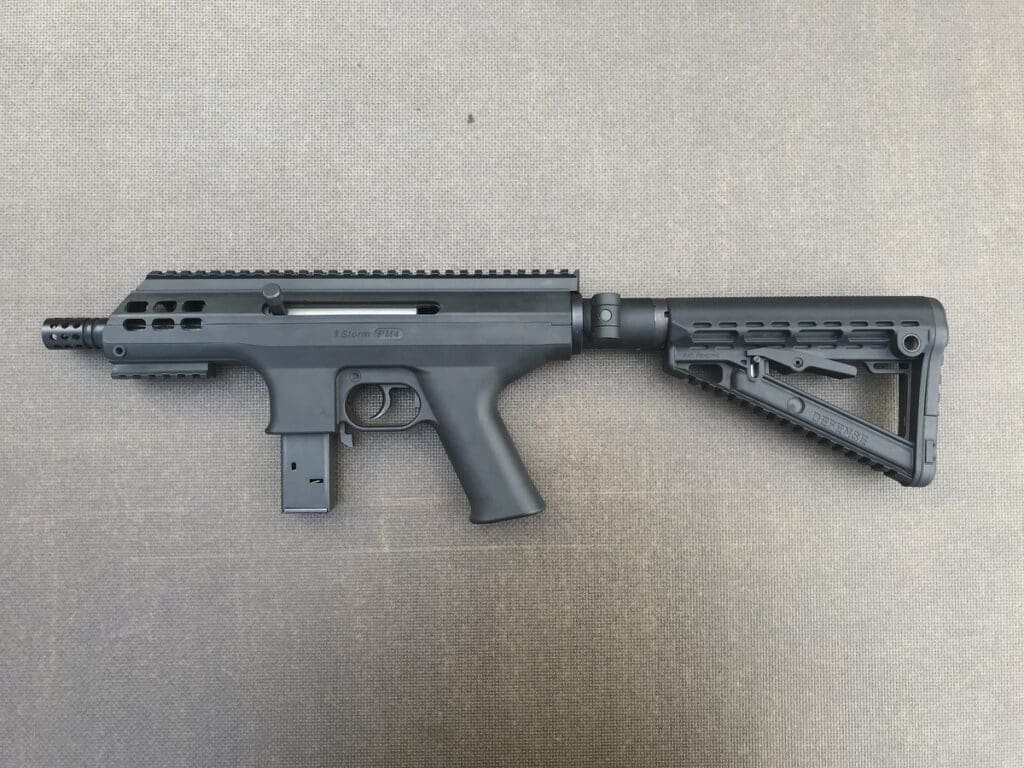
A return – or to be more precise, a true full-scale commercial launch – of the PM4 Storm pistol sometime in the future can thus not be ruled out.
The design would require some tinkering, to adapt it to the sensibility of the modern markets: Molina explicitly mentioned lengthening the overall action and chassis to accommodate Glock magazines, abandoning the .40 Smith & Wesson option which has long fallen out of favor with civilian shooters and professional operators worldwide, and replacing the original end cap and M4 buffer adapter with a vertical Picatinny rail that would allow more versatility and flexibility in the installation of sling rings, SIG Sauer MCX/MPX type stocks, arm braces, and the like.
But in today’s civilian firearms market, even in Europe, a firearm like the PM4 Storm does have its space, and for someone like the writer – who has been following the development of the design ever since the 2003 edition of EXA – it would really be a pleasure to see it finally come to fruition.
TECHNICAL SPECIFICATIONS
| Make | BCM Europearms S.A.S. |
| Model | PM4 Storm |
| Type | Semi-automatic pistol |
| Caliber | 9mm Luger, 9×21 IMI, .40 Smith & Wesson |
| Action | Semi-automatic, locked breech |
| Trigger system | SA/DA, with manual de-cocker |
| Safety | Manual de-cocker and automatic trigger safety |
| Capacity | 15, 20, 25, or 32 rounds in Uzi magazines |
| Sight systems | Full length top MIL-STD 1913 Picatinny rail for optics or sights |
| Barrel length | 5.7 in. |
| Total length | 15.5 in., with stock folded or removed |
| Weight (empty) | 5.51 lb. |
| Materials | Polymer, steel |
| Finishes | Matte black on all surfaces |
| URL | www.bcmeuropearms.it |



